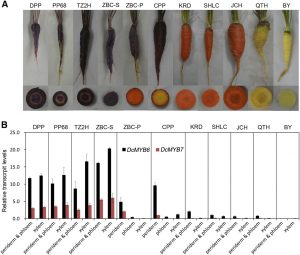How Carrots Get Their Colors
Carrot (Daucus carota ssp. sativus) are classified into two groups: the carotene group (variety sativus) and the anthocyanin group (variety  atrorubens). Carotene group members, also known as nonpurple carrots, accumulate massive amounts of carotenoids in their roots. Anthocyanin group members, also known as purple carrots, accumulate high levels of anthocyanins in their roots. Anthocyanins are water-soluble flavonoid compounds and confer red, blue, and purple pigmentation to plants. In addition to their important roles in plants, they are also beneficial human nutrients. Nonpurple carrots are considered to have arisen from purple carrots that acquired mutations. In addition, purple carrot root pigmentation extensively varies across different carrot genotypes, ranging from the purple peridermal carrot type (purple periderm but nonpurple phloem and xylem) to the solid purple carrot type (purple periderm, phloem, and xylem). A quantitative trait locus associated with anthocyanin pigmentation in purple carrot roots has been identified on chromosome 3 and includes two candidate genes, DcMYB6 and DcMYB7. Xu et al. (10.1104/pp.19.00523) have characterized the functions of DcMYB6 and DcMYB7 in carrots. Overexpression of DcMYB7, but not DcMYB6, in the orange carrot ‘Kurodagosun’ led to anthocyanin accumulation in roots. Knockout of DcMYB7 in the solid purple (purple periderm, phloem, and xylem) carrot ‘Deep Purple’ resulted in carrots with yellow roots. Evidence is presented that supports the hypothesis that another genetic factor suppresses DcMYB7 expression in the phloem and xylem of purple peridermal carrot root tissues. These results improve our understanding of the molecular mechanism behind the origin of the nonpurple root phenotype during carrot domestication and are also valuable for breeding programs aimed at modifying anthocyanin biosynthesis in carrot and other plant species.
atrorubens). Carotene group members, also known as nonpurple carrots, accumulate massive amounts of carotenoids in their roots. Anthocyanin group members, also known as purple carrots, accumulate high levels of anthocyanins in their roots. Anthocyanins are water-soluble flavonoid compounds and confer red, blue, and purple pigmentation to plants. In addition to their important roles in plants, they are also beneficial human nutrients. Nonpurple carrots are considered to have arisen from purple carrots that acquired mutations. In addition, purple carrot root pigmentation extensively varies across different carrot genotypes, ranging from the purple peridermal carrot type (purple periderm but nonpurple phloem and xylem) to the solid purple carrot type (purple periderm, phloem, and xylem). A quantitative trait locus associated with anthocyanin pigmentation in purple carrot roots has been identified on chromosome 3 and includes two candidate genes, DcMYB6 and DcMYB7. Xu et al. (10.1104/pp.19.00523) have characterized the functions of DcMYB6 and DcMYB7 in carrots. Overexpression of DcMYB7, but not DcMYB6, in the orange carrot ‘Kurodagosun’ led to anthocyanin accumulation in roots. Knockout of DcMYB7 in the solid purple (purple periderm, phloem, and xylem) carrot ‘Deep Purple’ resulted in carrots with yellow roots. Evidence is presented that supports the hypothesis that another genetic factor suppresses DcMYB7 expression in the phloem and xylem of purple peridermal carrot root tissues. These results improve our understanding of the molecular mechanism behind the origin of the nonpurple root phenotype during carrot domestication and are also valuable for breeding programs aimed at modifying anthocyanin biosynthesis in carrot and other plant species.



